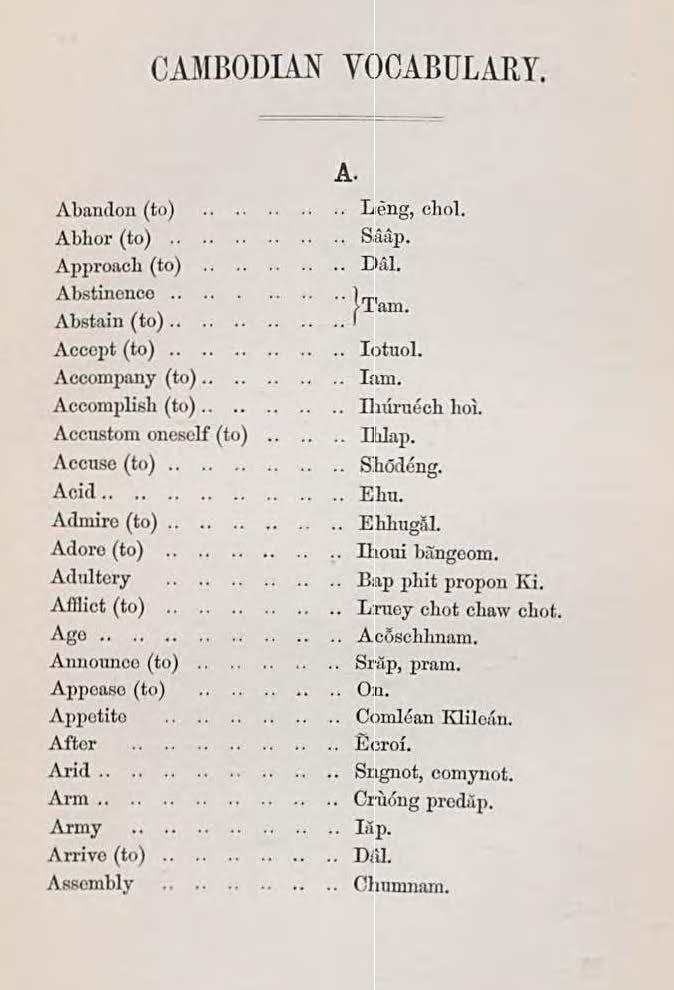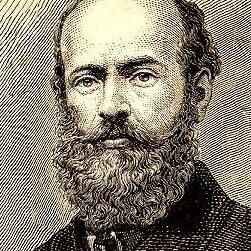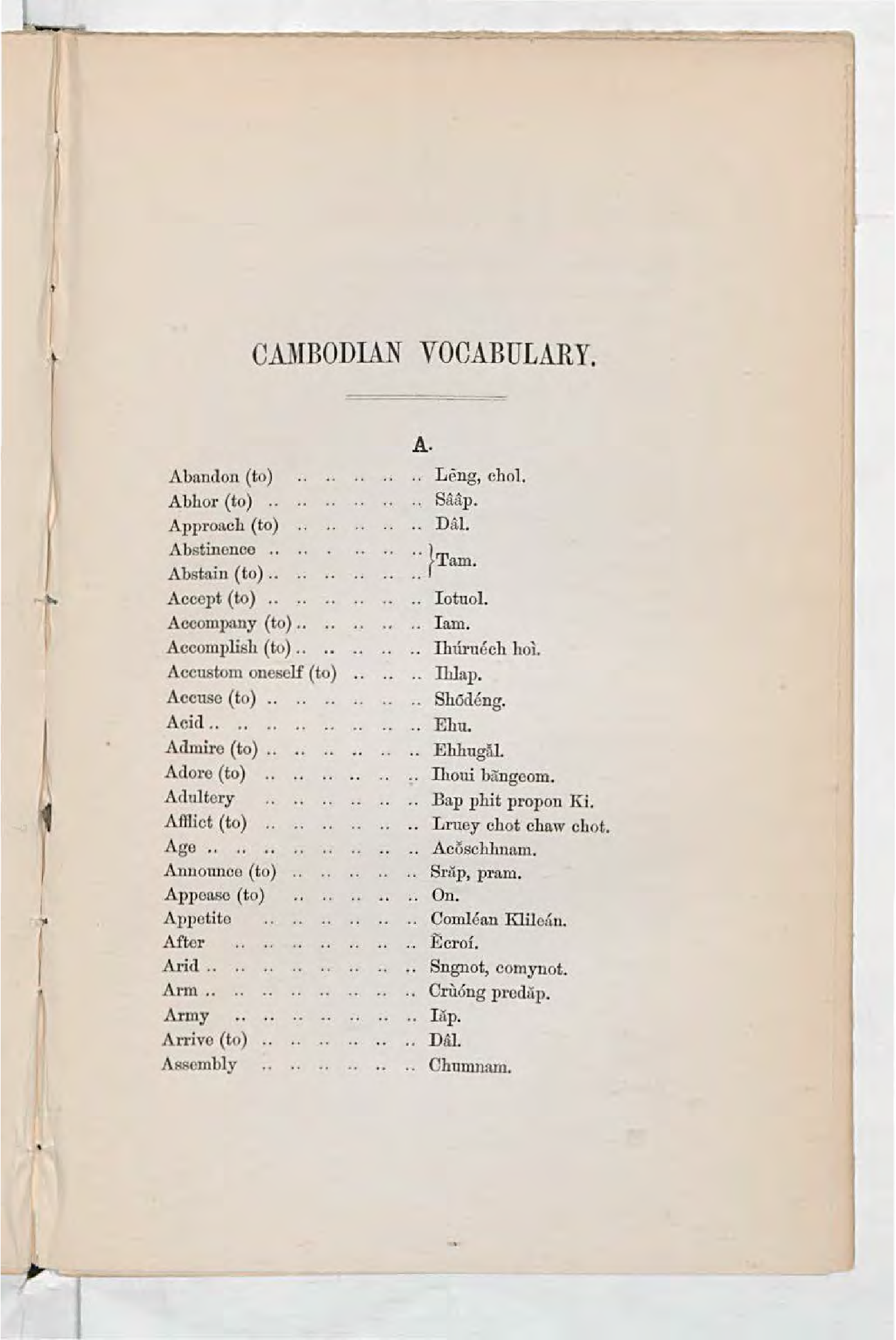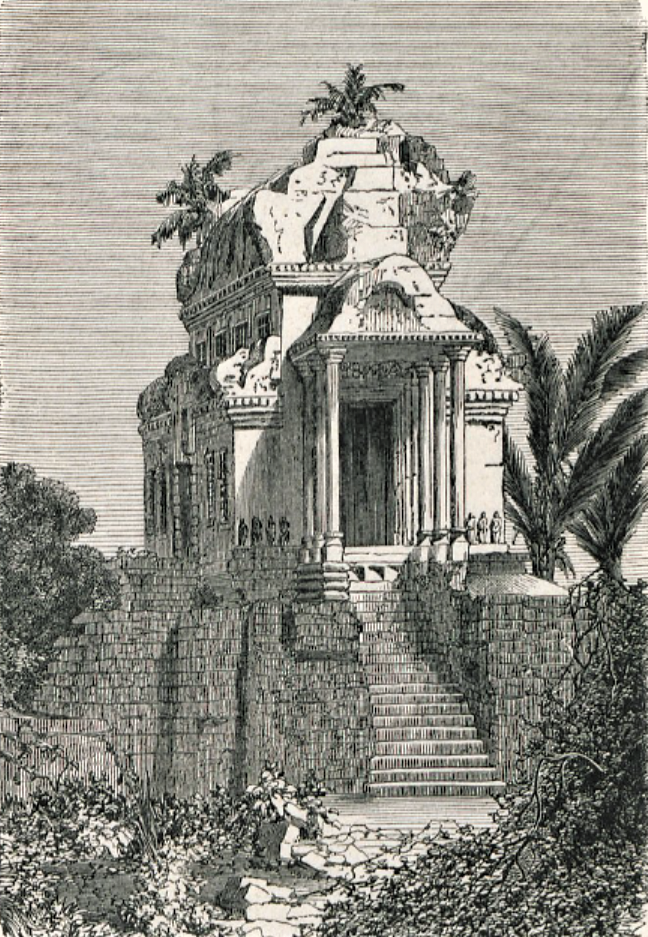A Cambodian Vocabulary by Henri Mouhot
by Henri Mouhot
An appendix to his Travels shows the famous explorer's interest in Khmer language.

Publication: from Travels..., John Murray, London | ADB Reference Documents (2022)
Published: 1861
Author: Henri Mouhot
Pages: 34
Languages : English, Khmer
pdf 9.2 MB
Published as an appendix to the English (and posthumous) version of his Travels, this “Cambodian Vocabulary” by Henri Mouhot shows the relatively substantial knowledge of the Khmer language the explorer, who was also a botanist and naturalist, adquired during his brief sojourn in Cambodia.
Leaving apart the references related to the time period (and to the help he received from English and French missionaries in Siam and Cambodia), such as a Khmer version of the Lord’s Prayer, this vocabulary reflects above all the concerns of a traveler (transportation means, health, basic needs of the daily life..).
From a linguistical point of view, it is interesting to note that 19th-century Khmer was already rather similar to the modern language of our times, and that, except from some lexical confusion — for instance thinking that “Tonle Sap” meant “lake” –, Mouhot’s ear captured the pronunciation quite accurately.
Here are some samples, compared to correct modern Khmer words:
- Girl: Consrey [កូនស្រី, in fact meaning “daughter”, “girl” should be ស្រីនាង (sreyneang)]’
- Heat: Cadau [កំដៅ, rather pronounced gdaw nowadays]
- Horse: Sê [សេះ, usually transcribed seh]
- Heart: Bedong [បេះដូង, usually transcribed bedaung]
- How much: Ponman [ប៉ុន្មាន]
- How: Doehmedech ? [យ៉ាងម៉េច?, rather transcribed yeangmech]
- Horn: Sneng [ស្នែង]
- Lake: Touli Sap [បឹង, boeng, Tonle Sap being the name of one lake]
- Love: Srelant [ស្រឡាញ់, sraleanh]
- Smooth (to): Smó, reling [ធ្វើឱ្យរលោង, thveu aoy r’long]
- Small pox: Ot [ជំងឺអុតស្វាយ]
- Saucepan: Chhang, ketea [ខ្ទះ, khteah, ចាន chan being all kind of crockery]
Tags: Khmer language, linguistics, 19th century, French explorers
About the Author

Henri Mouhot
Philologist, self-taught photographer and naturalist Henri Alexandre Mouhot (15 May 1826, Montbeliard, France ‑10 Nov. 1861, Naphan, Laos) started exploring South East Asia in 1857 with the support of the Royal Geographical Society and the Zoological Society of London. French authorities never supported his journeys aimed at natural sciences research.
Mouhot´s connection with Great Britain was also personal since he married in 1856 the granddaughter (or niece?) of famous Scottish explorer Mungo Park (1771−1806), Annette Park (18??, Berwick-on-Tweed — 1894), and lived with her in Jersey. His brother Charles, who traveled with him across Europe and Russia, married another of Park´s relative, Jane Elizabeth Mary Park.
Also, it has been said that John Bowring´s book published in 1857, The Kingdom and People of Siam, gave him the idea of visiting South East India. Last but not least, his travelogue around South East Asia was first published in London in an edition collated by Charles Mouhot in 1862.
His Journal and letters, later collated in the book Voyage dans les Royaumes de Siam, de Cambodge et de Laos (1868) for the French public, became a sensation for his description of Angkor, which he reached from the South in January 1860 (chapters 18, 19, 20). If he was not the first Westerner to access the Angkorian site, his relation was so vivid, detailed and well-written that ït gave him (posthumously) the reputation of being the first “Angkor rediscoverer”. [in 1874, Hachette Publishers included Mouhot’s book in its popular “Pink Library”, 3d series (“For teenagers, possibly in a library for young girls aged 14 to 18 years).]
Henri Mouhot, was had studied Greek and Latin and taught Greek at a Saint-Petersburg gymnasium during the twelve years he stayed in Russia, took some epigraphic notes on Khmer and Lao languages that are kept at the British Library (collection Or.4736) and can be viewed here. They are parts of Mouhot’s documents and notes which were brought to London by Dr. James Campbell and given to his widow, Anne Mouhot. She gave these papers to the British Museum in 1894, over 30 years after her husband’s death, and the originally loose-leaf papers (most of them dated 1860 and 1861) were recently bound together in book form by the British Museum.
Henri Mouhot died of malaria fever (called “fievre des bois” among the French explorers of Indochina) on Nov 10, 1861, in the vicinity of Luang Prabang, the southernmost Royal city of Laos. His grave, erected in 1867, has been rediscovered in 1989.
According to American Protestant missionary Daniel McGilvary, who visited the area in 1876 – 1877 (in A Half Century Among the Siamese and The Lao, An Autobiography, Fleming H. Revell Company, New York, 1912), “no doubt the real spirits are the malarial germs or the poisonous gas which later we found to be the chief danger of the Chieng Dāo cave. It was in this cave that M. Mouhot, a noted French scientist, contracted the fever from which he died. The natives believed that his death was caused by his rashness in trespassing upon the domain of the spirits who preside over the cave.”
As a naturalist in Laos, Mouhot is credited of numerous discoveries of numerous specimens of insects and shells that were not previously known to Western zoologists, including an impressive black beetle that was later named Mouhotia gloriosa, and an extraordinarily shaped spider now known as Cyphagogus Mouhotii.




